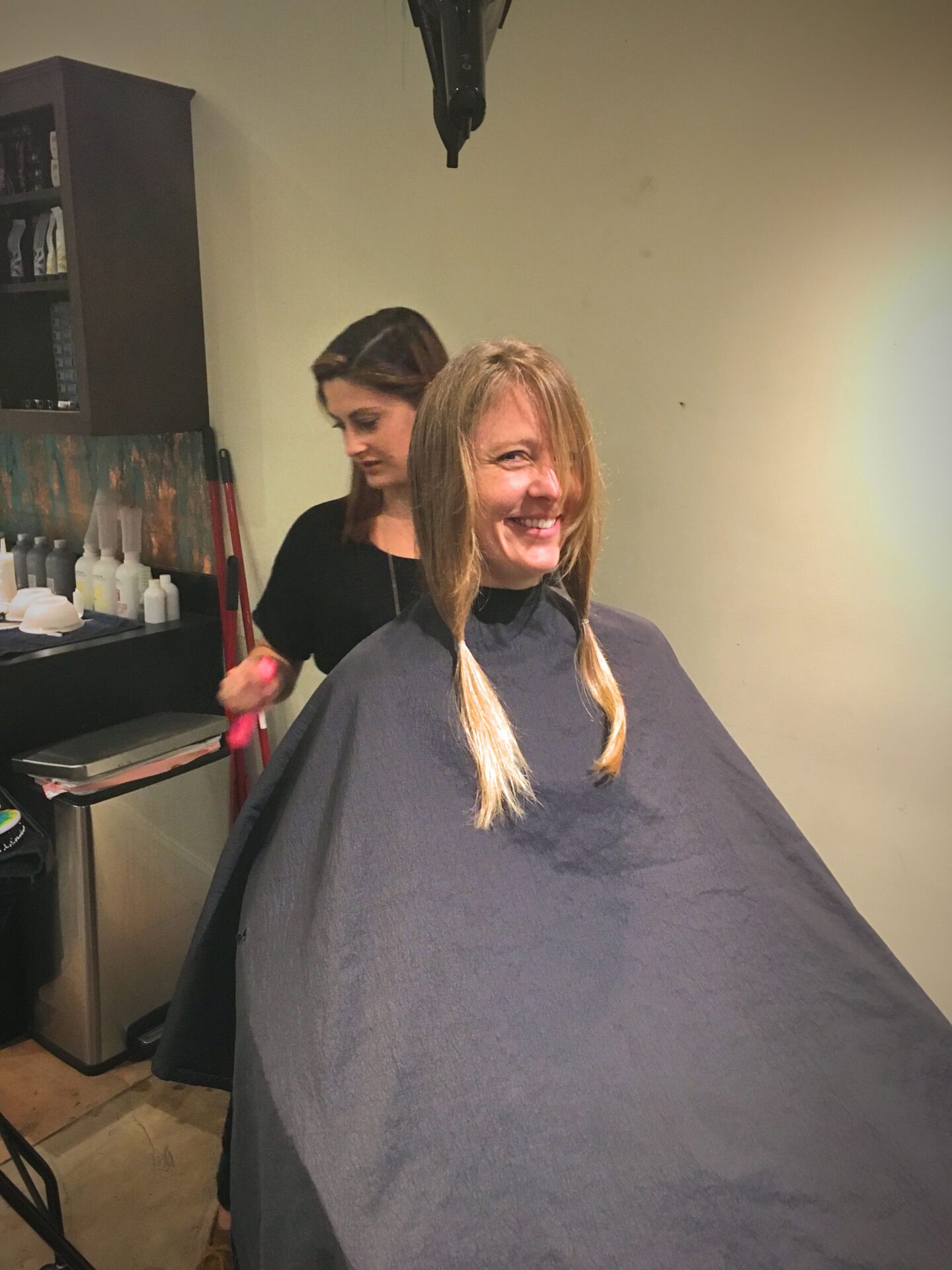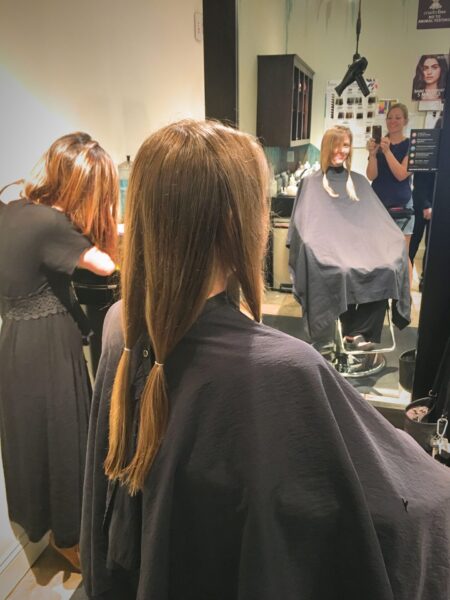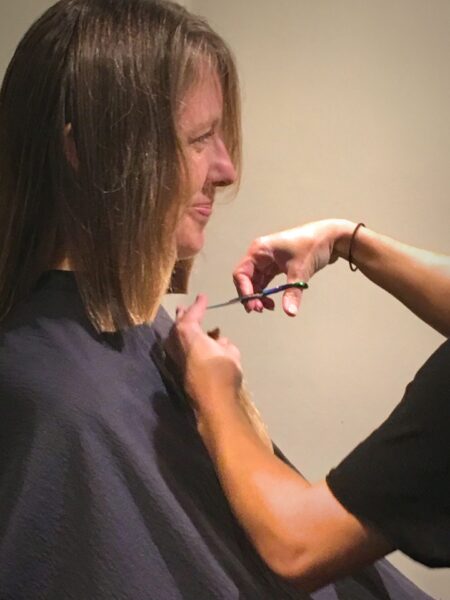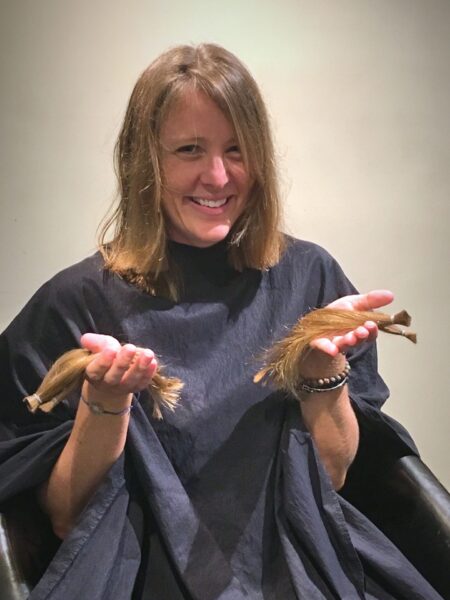
Years ago now, right before turning 40 (which was fraught, it turns out, with a lot of drama), I decided to donate my hair.
I am not sure when the decision happened. I had never consciously determined to grow my hair long for the purpose of donation. I usually keep my hair at a longer length anyhow. But at some point, I noticed how long it was and decided to let it keep going, for the purpose of donating.
But, very similar to my juice cleanse, what I learned about life and myself in the process was a total surprise.

Why Hair Donations Are Needed
Hair donation is often overlooked as a way to help, it turns out. Probably because it takes a significant amount of planning and a fairly major sacrifice (more on that later). Yet this can make a powerful impact in someone’s life.
There are two main candidates in need of hair donation: cancer treatment patients or those with alopecia.
Of course, synthetic fibers are used to create wigs. But they look, well, synthetic in a lot of cases. Additionally, synthetic wigs are harder to find and fit to children’s heads. Wig manufacturers also honestly state that wigs made from real hair last longer and allow for more styling (proving once again that we just can’t find a way to outdo God). Hence why companies have sprung up taking donations of human hair to create better wigs.
Why Donating Hair Matters to Someone
The effects of hair loss are devastating emotionally and mentally. Stay tuned to the end to read my personal response to just shearing my locks voluntarily…
But real studies have proven this.
Not surprisingly, the patients unanimously experienced decreases in self-esteem while undergoing chemotherapy. Hair loss also seemed to damage the patients’ perception of their own physical health and fitness, over and above the obvious impact having cancer, mainly ovarian cancer, would have on those two measures of psychological well-being. Losing hair made the patients feel sicker, or at least made the patients understand the reality of their disease more acutely.
Hair loss hurt the patients across all of these measures, self-esteem, perceptions of health and fitness and basic reasoning skills. But after chemotherapy, after their hair had grown back, most of the patients’ self-images did not “balance out” as you would expect. More than 73% of the patients felt less self-confident than they had before receiving treatment. Nearly half of the patients reported experiencing hair loss as “the most traumatic side effect of chemotherapy.” Such evidence suggests that while some hair loss may itself be temporary, alopecia’s psychological effects are almost always permanent.Munstadt, Manthey & Vahrson

What You Need to Know About Donating Your Hair
- You need to decide where you are going to donate your hair first, as that will determine the details. I donated through Pantene’s Beautiful Lengths, but that program has been dissolved. Some of the most popular organizations that still take hair donations today include:
Locks of Love
Children with Hair Loss
Wigs for Kids
Hair We Share - You need anywhere from 8-12 inches to DONATE, not total on your head. Unless you want to go all the way to scalp…
- Some places do not accept dyed/colored or grey hair for donation. (That’s why I did this before turning 40 – the greys were coming!) This link here has a really great chart: www.businessinsider.com/donating-hair-to-charity-what-you-need-to-know-2016-12
- Talk to your hairstylist before cutting, and be sure to really love and trust your stylist. After all, this is the person taking the hair off your head and then helping you shape a new ‘do you want to love. Additionally, the stylist should know the requirements. For Pantene’s Beautiful Lengths, hair had to be completely dry, in a ponytail and through a licensed salon. (In fact, they had an established relationship with Pantene’s program already and handled most of the details for me.)
- This isn’t like Compassion, where you become pen pals with the person who got your hair. In fact, you just have to trust that it was donated and used. One person’s donation isn’t usually enough to make an entire wig. So doing this also requires faith.

What I Learned When I Donated My Hair
Of course, I was nervous driving in and when I initially sat in that chair. In fact, one of my best friends in life was beside me to keep assuring me it was okay.
But, ultimately, I wasn’t too worried. I’ve never been a person too attached to my hair or outward appearance (hence why you don’t find beauty tips and posts on here). I have always been pretty sure that the inside matters more and while we were asked to be good stewards of our bodies and outward appearance (and as we know, appearance is rewarded or punished in a professional setting), I’ve never spent too much energy getting caught up in how I look and keeping up with trends.
OR SO I THOUGHT…

After that first cut happened, I felt exhilarated. I had done it and I felt great. Lighter, happier, on so many levels. It always feels good to do good – and it also feels good to follow through on a promise.
But, about three days later, when we went out for dinner, drinks and dancing to celebrate my birthday, I was in a totally different headspace.
I hated my hair. It was the shortest I had ever had it. And I knew I wanted to grow it out again, so any style taking MORE off was out. I ended up with what I called at the time a “middle aged mom cut” (and no, I don’t have a picture for reference – please just fill in the blank with however that resonates with you). We did the best with what we had.
Yet the fact that my hair wasn’t what I wanted – that it was wasn’t what I identified with – felt awful.
I realized, in a profound way, that our hair is where we display who we are. We make statements with it. That’s why new styles throughout our lives reflect the times, our mood, our goals, our professions, our friends, our ages…. It’s why we look back at photos of ourselves from times past and laugh at our haircuts. Our hair MEANS something. Even for those of us who (like me) don’t spend too much thought on hair on a daily basis, our hair is a huge part of how we create identity.
Our hair also gives us some element of control in our lives. We get to call the shots on how it looks, what color it is, how it matches our outfit, what we put in it. Our hair is something that we actively manipulate and make decisions about. For some of us, it is an outlet for creativity.
And, finally, I realized how much confidence our hair can give us. When we like the decisions we’ve made, we feel GOOD. We might not actively think about it when we like it, but it deflates our self-confidence when our hair is not what we want.
When our hair is good, we feel good. When our hair makes us sad, it takes a whole lot of brain space and emotion from our days.
So:
Can you imagine being in a situation where an illness or a treatment has you losing your hair or unable to grow any?
All of those feelings of identity, control and confidence must feel more elusive
I learned in three days that I don’t like living with hair that I don’t get a real say in. I couldn’t imagine living with that feeling for months, years or a lifetime.
This was a challenge that felt like a real sacrifice to me. And it made the struggle of hair loss feel closer.
Of course, I still don’t really know the feelings of acute hair loss. I don’t know what strength it takes, or what women and men decide as they go through either hair loss or alopecia. Me just cutting off my hair is in no way the same as not having any.
But I am glad I did this. I came closer to the human condition and grew in understanding. I walked just maybe one teeny footstep in those feelings of helplessness and almost shame.
And today I love my hair even more – I have so much gratitude for it.
I encourage you to think of ways to give to women, men and children who may be seeking confidence and love in the form of hair they can be proud of. Let’s all take one teeny footstep in someone else’s feelings.
